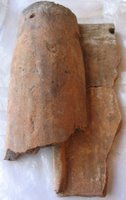Curved and flanged tile functioned in the same way as the Roman imbrex and tegula. The following examples are from MAP Archaeological Consultancy's Spurriergate, York, site.
This is a flanged tile, with a nail/peg hole. Only half of one, but a complete one can be seen at the Museum of London catalogue site here:
 Here is a curved tile that would have gone along with the flanged tile above. As ever, it's not quite complete. Note it also has a nail/peg hole:
Here is a curved tile that would have gone along with the flanged tile above. As ever, it's not quite complete. Note it also has a nail/peg hole: Although I have seen some partially glazed examples in York, it does not appear to be particularly common in the city.
Although I have seen some partially glazed examples in York, it does not appear to be particularly common in the city.Here is how the tiles would be fitted together. Unlike Roman tiles, these tiles don't tend have upper and lower cutaways to lock into the next tiles on the roof. However, sometimes the flanges tiles as a whole taper toward the bottom, or the flange itself is slightly tapered at the end:

No comments:
Post a Comment